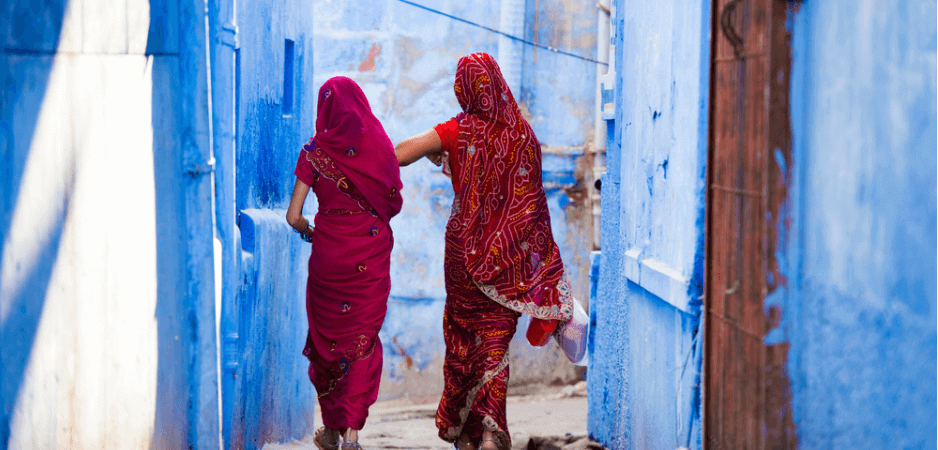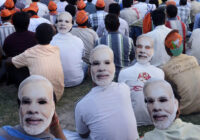The right-wing promise to protect “Hindu traditions” offers shelter to male constituencies troubled by the apparent threat of women’s professional and sexual independence in modern India.
In his savage book, Capital: The Eruption of Delhi, on the nature of India’s capital’s transformation as a global metropolis, Rana Dasgupta describes the besieged forms of Indian patriarchy in the modern city that, he argues, signal a crisis for the traditional values of north Indian men. In this narrative, Dasgupta describes a “war against women,” as single females increasingly find their way into professional lives away from the traditional structures of the family. The book’s sections on gender violence were clearly influenced by the gang rape and murder of Jyoti Singh Pandey in December 2012.
The rape elicited a massive international response, prompted a designation of city as a “rape capital” and spurred a renewal of mass movements calling for legislation around women’s security.
The wider politics of the case, however, were perhaps more significant than the visceral outrage around sexual violence itself. Jyoti Singh was lionized as a symbol of Indian womanhood. Given the name “Nirbhaya” (fearless) in the media, her fate symbolized, for many, women’s struggles in India. The respectability and background of Singh as a victim, coupled with the criminality of her rapists and murderers as backward-caste slum dwellers, was highlighted in the media as a symbol of the ideal of Indian womanhood under threat.
Another powerful image attached to Jyoti Singh, however, was the assumption that her modernity was, itself, a key condition of her victimhood: Good Indian women needed to watch how they dressed in public, the violence against them a symptom of their Westernization. Meanwhile, the routine and disproportionate violence against Dalit (those belonging to the lowest castes or outside the caste system) women is much less publicized, let alone reported or prosecuted. While the conviction rate for rape cases in India stands at about 24%, for cases involving Dalits it was as low as 2% in 2014.
Sexual Violence as Social Control
These representations of and silences around sexual violence in India have been transformed and expanded in important ways with the political success of the Hindu right since the beginning of this decade. The growing political authority of Hindutva (philosophy of the Hindu right) and the mobilization of its popular base through its main institutions (collectively known as the Sangh Parivar), have concentrated and amplified two long-term patterns.
Firstly, incipient sexual violence — the fear of its occurrence and the discourses surrounding it — has, for at least a century, underpinned the very project of anti-colonial Indian nationalism. Not only were the ideals of pure Indian womanhood pivotal to the protection of an inner “spiritual” sphere that opposed Westernization, but in the interwar period, as the idea of the Indian citizenry formed, women’s honor was at the center of the idea of India.
Secondly, sexual violence has become a routine practice of social control with distinct implications for the politics of caste in India. This also has a historical legacy in the use of rape, violence and abduction during India’s Partition of 1947. Today rape, and gang rape in particular, has become a typical form of deliberate community shaming that is used as a mechanism for controlling or eliminating Dalit and Adivasi (tribal) communities. Both the ideology of women’s honor as national symbol and the practice of rape as social control have been expanded in the context of the Hindu right’s mode of politics.
The Sangh Parivar’s political appeal and mobilization strategies have always relied upon a range of methods for demonizing Muslims globally. Its key repertoire, which has developed since at least the 1920s, is the assertion of Hindu hypermasculinity as a defense against the presumed hypermasculinity of Muslim men. These gendered postures have been strongly based on notions of an idealized Indian womanhood which depicts women’s worlds as polarized between, on the one hand, a mythical “Indian” traditional sphere based in wifely obedience and spiritualized modesty and, on the other, external influences that came with colonial encounters or contact with other communities, such as modern dress, independence and the apparent breakdown of the extended family.
A new poll has found #India to be the most unsafe country for women. In The Snake Charmer, we ask how #Bollywood contributes to a culture of sexual violence against women in India. Share your thoughts with us.
Stream here: https://t.co/pd6dM1XAEd pic.twitter.com/nBaBFkQbv3
— Witness – Al Jazeera (@AJWitness) June 27, 2018
As Charu Gupta has shown, in interwar India these ideas often revolved around anxieties of masculinity that developed through Hindu-Muslim competition and were characterized by media-generated abduction crises and targeted violence against women. Against the depiction of Islam’s lust and perversion, Hindu organizations posited women as sexualized embodiments of their community’s honor. The bodies of women, both metaphorically and literally, became the battleground of different concepts of the nation.
In a situation of perpetual popular conflict between Hindus and Muslims, which has accompanied many elections of Bharatiya Janata Party (BJP) candidates and the ongoing encouragement of hypermasculinity, this battleground has been revived. Its most obvious manifestation is in the Sangh’s indirect deterrence, via khap panchayats (traditional caste councils), of women’s use of mobile phone technology, on the “love jihad” scares around inter-communal relationships between young people, and in the anti-Valentine’s Day attacks on couples in public places. All of these attacks on free sexuality, often spearheaded under the auspices of the Sangh and its offshoots, have increased since 2008.
The significance of sexual violence as a function of social paternalism — our second theme — has also changed under India’s right-wing regimes, albeit in a way that continues to share some of the characteristics of the sexual violence and mass abductions of 1947. A high proportion of members of parliament and the legislative assembly (MLAs), especially in north India, carry criminal records, and it has been noted recently that BJP politicians have the highest proportion of convictions for crimes against women of any party.
But, more importantly, both state level BJP governments and cadres of the Sangh Parivar have overseen the extended use of sexual violence as a means of socially controlling and humiliating low status communities across India. In 2016, India’s National Crime Records Bureau produced a report showing that, as well as crimes against Dalits and Scheduled Tribes (STs) increasing in general since the 2014 election, over 2016 BJP-majority states had much higher rates of such crimes. For example, Madhya Pradesh had a crime rate against Dalits that was double the national average, and the crime rate of rape committed against Dalits and STs was significantly higher than the national average in most BJP states.
Political Cover-Up
In some respects, the association of the Hindu right with sexual violence relates to political cover-up. In the BJP-ruled north Indian state of Uttar Pradesh — the most populous and politically important region of India — BJP politician Kuldeep Singh Sengar was arrested for rape this April, having also arranged the beating of the victim’s father. Despite the victim’s attempted self-immolation in front of his house, the state chief minister, Yogi Adityanath, shielded the accused.
The pattern of anti-Dalit sexual violence is more significant as a form of routine political and social control, and it is here that the example of the recent child gang rape case in Kathua, Kashmir, is illustrative. The body of 8-year-old Asifa Bano was found on January 17, 2018. She had been gang-raped by eight men, including government officers and figures with links to the BJP. Asifa was from the Gujjar community of nomadic Muslim shepherds. Following the arrests, the Hindu Ekta Manch launched a rally in support of the accused, which involved the participation of two BJP MLAs. When Asifa’s family attempted to bury her, local Hindus forced them to move her body to a neighboring village. Witnesses to these events argued that the gang rape and killing of Asifa were about territory, and the alleged encroachment of the Gujjars onto land previously controlled by dominant Hindu families.
Like right-wing regimes in other states globally, the BJP and Sangh Parivar have targeted minorities and the structures of affirmative action, as a means of generating popular support. But India’s extensive and radical constitutional structures have made it difficult for right-wing governments to dismantle the legal rights frameworks for the country’s most marginalized groups. No doubt, the Sangh and its many offshoots have been chipping away at these institutions in the last four years. The BJP’s political constituencies still depend, in its core heartlands, upon a high-caste chauvinism built from the early 1990s.
But much more widespread and more effective than this larger formal political goal have been the informal actions of local Sangh Parivar cadres and associated movements in an ideological and material war for the establishment of Hindu majoritarianism. In this struggle, the longer-term practices of hypermasculinity as a means of establishing pockets of social control have placed women in a precarious position. Without doubt, the Sangh’s promise to protect “Hindu traditions” offers shelter to male constituencies troubled by the apparent threat of women’s professional and sexual independence in modern India.
*[The Centre for Analysis of the Radical Right is a partner institution of Fair Observer.]
The views expressed in this article are the author’s own and do not necessarily reflect Fair Observer’s editorial policy.
Support Fair Observer
We rely on your support for our independence, diversity and quality.
For more than 10 years, Fair Observer has been free, fair and independent. No billionaire owns us, no advertisers control us. We are a reader-supported nonprofit. Unlike many other publications, we keep our content free for readers regardless of where they live or whether they can afford to pay. We have no paywalls and no ads.
In the post-truth era of fake news, echo chambers and filter bubbles, we publish a plurality of perspectives from around the world. Anyone can publish with us, but everyone goes through a rigorous editorial process. So, you get fact-checked, well-reasoned content instead of noise.
We publish 2,500+ voices from 90+ countries. We also conduct education and training programs
on subjects ranging from digital media and journalism to writing and critical thinking. This
doesn’t come cheap. Servers, editors, trainers and web developers cost
money.
Please consider supporting us on a regular basis as a recurring donor or a
sustaining member.
Will you support FO’s journalism?
We rely on your support for our independence, diversity and quality.






